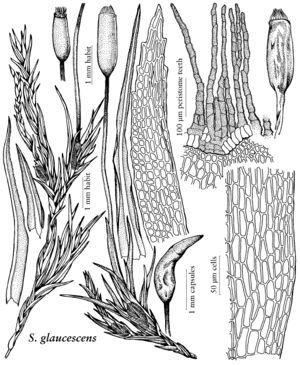Saelania glaucescens
in J. O. Bomansson and V. F. Brotherus, Herb. Mus. Fenn., Musci, 53. 1894,.
Leaves 1–2.5(–3.5) mm, proximal leaves small, the distal and perichaetial leaves gradually acuminate, ± subulate from a lanceolate base; costa with a single row of guide cells, and both adaxial and abaxial stereid bands, or adaxial stereid band sometimes weak or rarely absent; lamina cells often irregularly 2-stratose towards the apex and occasionally elsewhere. Seta to 15 mm. Capsule with operculum to 1 mm. Spores 15–20(–22) µm, greenish to yellow-brown.
Phenology: Capsules mature early summer–late fall.
Habitat: Soil on steep banks, particularly those protected by overhangs, frequent on roadsides, soil in sheltered rock crevices
Elevation: moderate to high elevations
Distribution
Greenland, Alta., B.C., Man., N.B., Nfld. and Labr. (Nfld.), N.S., Ont., Que., Yukon, Alaska, Ariz., Colo., Iowa, Mich., Minn., Nebr., N.J., N.Y., n Eurasia, e Asia, s Africa, Pacific Islands (Hawaii, New Zealand).
Discussion
The whitish to bluish coloration of the leaves is characteristic. Often thought to have been fungal or cyanobacterial in origin, the granular or thread-like surface material responsible for the glaucous coloration is a diterpene.
Selected References
None.
